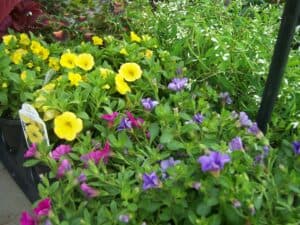
By Jennifer Fairfield
April is such a great month for gardeners – we get so hopeful as we start to see plants popping up out of the ground and buds forming on trees, the songs of frogs and birds begin to fill the air, and days grow longer. All of these things tell us it’s time to get gardening.
With the quick warm-up we seem to be getting, it’s tempting to get outside and start planting. Don’t be in too much of a hurry though – it’s important to know when to plant what, in order to give your plants the best chance to thrive. There are still lots of things you can do, both indoors and out, though.
Indoor and Outdoor Gardening Tasks:
If you didn’t do it in the fall or over the winter, make sure your garden tools are ready for the season – sharpen and clean pruners, loppers, and shovels (you can find many videos online to help you properly sharpen all of your garden tools); check gloves and garden hoses for holes; assess garden supports and stakes to make sure they are in good shape. Replace whatever won’t make it through the season. Have your lawn mower and other power equipment serviced so that it’s ready to go when the grass starts growing. Inventory seeds to make sure you have what you need – then go get anything you’re missing early so you have the best selection.
Start eggplant, pepper, and tomato seeds indoors now, so they will be ready to put out in your garden in about eight weeks. These heat-loving plants should not go outside until all chance of frost has passed, and nighttime temperatures are consistently above 50°, which is usually around Memorial Day.
Before starting to plant outdoors, test your soil. Your soil conditions change over time, so it’s best to do this every year. Knowing what your soil is lacking makes giving it what it needs to support good plant growth so much easier. You can do a simple soil test at home, or get a more in-depth analysis from the Michigan State University Extension Service.

As it starts to warm up, pulling mulch away from plants that are starting to poke up out of the ground can help the soil warm up more quickly, and can help to reduce mold. Add compost to the soil around your plants after you have removed mulch. This helps improve the soil’s structure and adds nutrients.
Wait to add new mulch to your planting beds, trees, and shrubs until the soil has warmed up fully – usually after Mother’s Day, or even as late as Memorial Day weekend. Putting down new mulch too soon can keep the soil from warming up and slow your plants’ growth and flowering. Spring mulching should be done in a thinner layer than fall mulching – just a couple of inches is perfect for helping to suppress weeds and keep the soil temperature and moisture consistent.
If you haven’t gotten the chance yet to clean up all the debris from our March weather, a warm, sunny day in April is a great time to do it. If you have the ability to pile the debris somewhere on your property that is out of the way, you can provide habitat for creatures, including some bees, butterflies, and other beneficial insects. Insects we don’t necessarily think of as beneficial will also use the dead wood, providing food sources for birds and other creatures.
When daytime temperatures are consistently in the 50’s, cut back grasses and most perennials that you left standing over the winter. The reason to wait until it has warmed up is to give the beneficial insects that have spent the winter in the hollow stems and on the leaves of your plants a chance to wake up. If you just have to cut things back and clean up earlier, don’t discard what you remove – carefully place it somewhere else on your property that is out of sight.
If you remove the debris from your yard altogether, you remove those insects (bees, butterflies, and other beneficials like praying mantis) from your yard as well, and you lose the great things they can do for your gardens. The Xerces Society has more details about when to do spring clean-up so you do the least harm.
Wait to cut back semi-woody and woody perennials until the end of the month, then decide how much you want to trim based on where you see new growth, and how you want the plant to appear. Semi-woody perennials are ones that form woody stems, but aren’t as substantial as true shrubs or trees, and include Russian sage, lavender, and some thymes.
Early April is the time to apply weed preventer to your lawn. Weed preventers help keep the seeds of dandelion, crab grass, and other weeds from putting down roots when they germinate. It won’t kill perennial weeds that already exist in your lawn but will keep new seeds from taking hold.

Once your garden’s soil is workable, it’s time to start planting cool-season crops, such as pea, lettuce, and spinach seeds. Radishes and carrots like slightly warmer soil, as do cabbage, kale, broccoli, and cauliflower transplants, and onion sets. The best way to know when to plant anything is by checking the soil temperature. All plants thrive at particular temperatures or ranges of temperatures. If you plant too soon, seeds will more likely rot before they can germinate, and transplants can end up being stunted and not produce well.
Use a soil thermometer to make sure that your garden is ready for planting. The University of California’s Extension Service offers a great chart with soil temperature ranges for seed germination. The MSU Extension Service has more tips on when to plant both seeds and transplants.
Pansies and primrose can also go out now, but keep row covers handy – even though it’s warming up nicely at the moment, we all know what April in Michigan can be like. We are pretty much guaranteed to get some really low temperatures still, and new growth is more tender than old, so your plants are more vulnerable at this time. Row covers can help protect your plants from frost and freeze, by keeping the warmth of the soil around the plant.
Sweet pea seeds can be planted outdoors when soil temperatures have reached 50°, bachelor’s buttons and calendula at 60°, and most other spring annuals when the soil is at least 65° to 70°.
Toward the end of the month, divide summer-blooming perennials that you didn’t get to in the fall (you can divide spring-bloomers, but they may not bloom this spring).
Plant dormant trees and shrubs once the soil can be worked. Proper planting of trees and shrubs is important in ensuring that they survive and thrive. The Arbor Day foundation has details for planting various types of trees, which can also be applied to shrubs.

For the Birds:
If you don’t have bird houses up yet, get them up now. I have seen lots of bluebirds checking out my nesting boxes already, so I’m hopeful that I’ll have bluebird babies in my yard this spring. If you’re interested in attracting bluebirds to your yard, the Michigan Bluebird Society has lots of great tips.
Check existing bird houses before cleaning them out to make sure they aren’t already occupied. If the nesting materials in the box look at all new and fresh, leave them – it’s an indication you already have tenants. If the materials look old, clean them out to give the birds a fresh start.
Another way to help birds during nesting season is to provide nesting materials for your birds. Just be sure you know what is and isn’t safe for the birds, as some things can be downright dangerous. Check out the Cornell Lab of Ornithology’s website to learn the do’s and don’ts of helping the birds out with nesting materials.
If you are wondering when hummingbirds will start arriving in our area, check out Hummingbird Central’s website that tracks the migration. Right now, they are still a bit south of us, but it won’t be too long before we start seeing them at our feeders, and orioles should be showing up at about the same time.
Make sure your feeders are ready for them – check for cracks and replace them if needed. With warmer temperatures, put your feeders out during the day to help early arrivers find food. If the temps dip below freezing at night, be sure to bring the feeders indoors to prevent cracking.


















